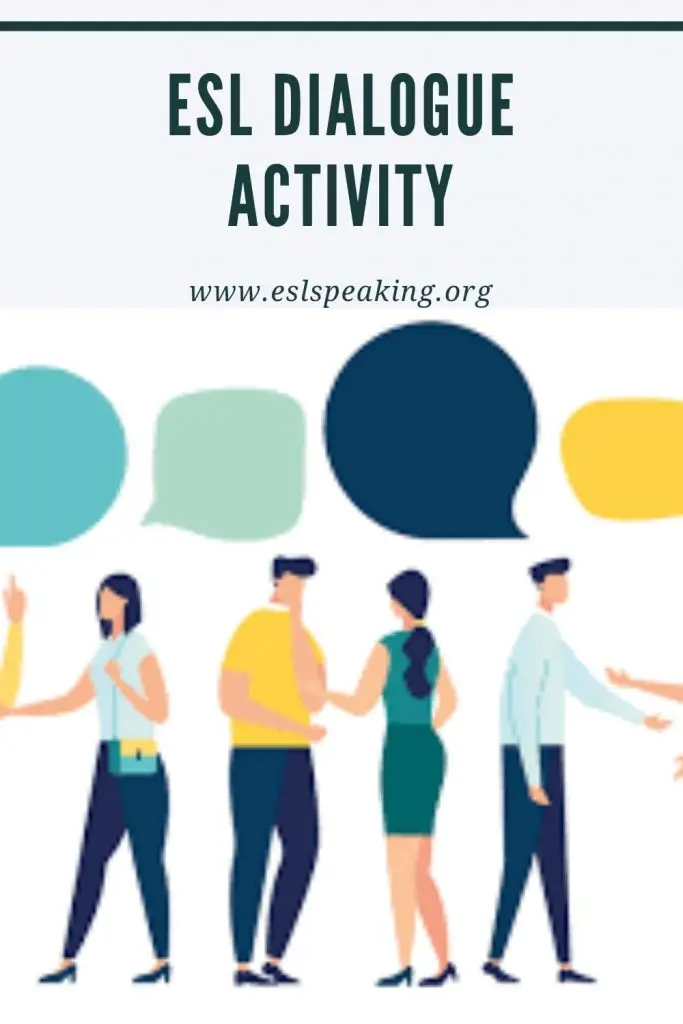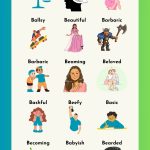If you want to help your students out with remembering new vocabulary words, then check out this ESL dialogue activity. Instead of just reading an ESL dialogue mindlessly, students have to fill in the blanks with key words that you’ve given them. It’s a nice way to increase the difficulty of a simple ESL conversation dialogue that you can often find in textbooks. Try this out for dialogues for ESL students.

ESL dialogue activity
Works a whole lot better, right? That’s assuming your goal is to help your students out with vocabulary! Keep on reading for all the details you need to know about this ESL conversation dialogue activity for kids as well as adults.
ESL Dialogue Substitution Activity
Skills: Reading/Listening/Speaking
Time: 10-15 minutes
Materials: PowerPoint or handouts of photocopied textbook dialogue with parts removed.
Lower-level textbooks contain many dialogues but their effectiveness is reduced when students don’t have to listen to their partners in order to successfully complete their roles. An easy solution to this is to use dialogue substitution which provides the dialogues with key elements missing (comparatives or infinitives and gerunds for example). Or, you may want to try it with giving directions as well.
Students then have to listen in order to respond appropriately. Dialogues are an excellent way for students to see how new vocabulary is used in real-life situations.
Remember that the goal is to challenge your English learners during your lessons! Keep on reading for all the information you need to use this activity successfully in your classes. Let’s get to it!
Teaching Beginners: Consider Scaffolding this Dialogue for ESL Students Activity
You may want or need to scaffold this activity by providing a list of possible words, phrases, or grammar patterns that could be used to fill the gaps. Alternatively, you can make the activity more difficult or realistic by allowing students to complete the dialogue using any language that makes sense, even if it hasn’t been presented in that lesson.
This activity is also useful for reviewing some basic conversation strategies: asking a speaker to repeat what he/she has said, or asking for clarification (as well as others). This is an area where students may need a bit of scaffolding, such as a few ways to politely ask others to repeat themselves:
One more time, please?
Sorry, I didn’t understand.
Also, remind students that when they speak to someone, they should be looking at the person, rather than at a handout or screen. Doing this makes this dialogue activity much more useful.
- Amazon Kindle Edition
- Bolen, Jackie (Author)
- English (Publication Language)
- 148 Pages - 03/09/2016 (Publication Date)
ESL Dialogue Topics
There are certain topics that lend themselves better to this activity than others. For example, food or sports, directions, school or classroom life often work well. Holidays, or planning for them lend themselves well to this too (for more ideas, check out: ESL Thanksgiving Games).
You just want to make sure that there’s a distinct word for each blank spot and it’s not too ambiguous.Something like culture, travel or health might be too difficult! But, of course, it depends on the level of your students.
What about Dialogues for Business English?
If you teach business English to lower-level students, then you may find this activity particularly useful. It can lend itself well to all sorts of things like:
- At the airport
- Phone conversations
- Answering questions about a product
- Small talk with customers
- Etc.
A quick tip: Ask your students what they want to work on, or what situations they feel nervous about. Adults are usually quite willing to tell you. Then, you can build your own dialogues for ESL students around this. It’s a great way to make your class even more useful.

ESL dialog
Teaching Tips for Dialogue Substitution:
This can work with any size class, but you may need to remind students to use their “inside voices.” Also be sure to circulate around the class monitoring their language choices, and making corrections as needed.
This activity is best for beginners to low intermediate students. Advanced level students are able to have conversations without the framework already there like lower-level students need.
Teachers often neglect pronunciation skills, but this activity lends itself well to some focus on it. Point out particularly difficult words or phrases before getting started.
Procedure for this ESL Dialogue Activity:
- Before class, scan or photocopy a textbook dialogue with the target language removed.
- Optionally, create a list of possible words or phrases that students can use to complete the dialogue or, encourage students to use other words or phrases that will fit the target language. Also, introduce any language needed for practicing communication strategies (see above).
- Divide students into pairs and have them take turns being A and B.
- To extend the activity, have students change partners and repeat the dialogue, using different words to create a new conversation.
Like this ESL Dialogues Activity?
- Amazon Kindle Edition
- Bolen, Jackie (Author)
- English (Publication Language)
- 57 Pages - 10/26/2015 (Publication Date)
If you found this ESL dialouge activity useful, then you’re going to love this book: 39 ESL Vocabulary Activities: For Teenagers and Adults. It’s the book you need if you want your students to have fun while learning new English words.
The book is available on Amazon in both digital and print formats. It’s super easy to download the e-version onto any device by using the free Kindle reading app. Yes, it really is that easy.
You can keep a physical copy on the bookshelf in your office to use as a handy reference guide when you’re doing your lesson plans. Or, take a copy with you on your phone or tablet to your favourite coffee shop for lesson planning on the go.
Check it out for yourself over on Amazon, but only if you want to get yourself some ESL awesome in your life:
FAQs About Using Dialogues in ESL/EFL Classes
There are a number of common questions that people have about this topic. Here are the answers to some of the most popular ones.
What are ESL dialogues?
ESL dialogues are scripted conversations used for language practice, allowing learners to engage in realistic interactions.
How do ESL dialogues benefit language learners?
They provide models for natural conversations, improve listening and speaking skills, and build vocabulary and grammar proficiency.
How can I use ESL dialogues in the classroom?
You can use dialogues for role-playing, listening exercises, reading comprehension, and as models for creating original conversations.
What types of dialogues can I use?
Dialogues can cover various scenarios like ordering food, making phone calls, introducing oneself, asking for directions, and more.
Can dialogues be adapted for different language proficiency levels?
You can adjust the complexity of dialogues to match beginners, intermediate, and advanced learners.
What’s the benefit of role-playing dialogues?
Role-playing dialogues help students practice real-life scenarios, encouraging active language use and building confidence.
How can I encourage creative dialogue practice?
Ask students to modify dialogues by changing settings, characters, or outcomes, fostering creativity and critical thinking.
How do I ensure effective pronunciation practice with dialogues?
Pay attention to pronunciation while practicing dialogues, emphasizing clear speech, intonation, and stress patterns.
Can dialogues promote cultural understanding?
Yes, dialogues featuring cultural contexts can help learners understand cultural nuances in communication.
How can technology be integrated with dialogues?
Use audio recordings of dialogues, subtitles in videos, or online dialogue generators for interactive practice.
Are dialogues suitable for group activities?
Yes, group role-playing activities using dialogues encourage interaction and teamwork.
How can I personalize dialogues for ESL learners?
Have students rewrite dialogues with their own details, making the conversation more relatable and meaningful.
What’s a creative way to assess dialogue understanding?
Have students create comic strips or visual representations of the dialogue, showcasing comprehension and creativity.
How can dialogues enhance listening skills?
Play audio recordings of dialogues and ask questions to test comprehension, helping students tune into spoken language.
Have your Say about Substitution Activity for English Learners!
What are your thoughts about this ESL dialogue practice? Do you think it would work in your classes, or do you have another go-to one that you’d like to share?
Leave a comment below and let us know what you think. We’d love to hear from you.
Also be sure to give this article a share on Facebook, Pinterest, or Twitter. It’ll help other busy teachers, like yourself find this useful ESL conversation dialogue activity.
Last update on 2024-04-14 / Affiliate links / Images from Amazon Product Advertising API








Love the idea of taking out some of the key words in dialogues. I find that they’re just usually too easy and so I usually skip over them. This takes it up to the next level though and actually requires that students put some thought into it.